Electric scooters will keep driving on the sidewalks

After almost two years, the discussions of traffic experts and politicians ended with amendments to the Road Traffic Law, providing in it a place for electric scooters as well. The electric scooter has now evolved from a "sports or leisure equipment" into a full-fledged traffic participant with all the resulting duties and responsibilities.
It has not been possible to get this heavy and unstable vehicle off the sidewalks, but now it will be much easier to resolve conflict situations, and the police will be able to monitor the drivers if necessary, calling them to order if needed. Section 1 of the Road Traffic Law states what an electric scooter is:
91) electric scooter - a vehicle equipped with an electric motor, the maximum design speed of which does not exceed 25 kilometers per hour, which does not have pedals and which is intended for one person and is equipped with a steering wheel or armrest mechanically connected to the footrest;
Speed is limited
So-called micromobility is a welcome thing, because every citizen who does not use a car reduces congestion and air pollution. But with the massive emergence of electric scooters in 2019, various difficulties and conflicts began in urban traffic, mainly with pedestrians. This is partly due to the rental offices, which started offering the new means of transport in the absence of any regulation. Up until now, electric scooters might as well have been equated with a beach float, from which it is practically impossible to claim liability for damages.
The electric scooter together with the rider is relatively heavy - about 100 kilograms. Compared to pedestrians, it travels very fast - up to 35 kilometers per hour. Accordingly, if a pedestrian is hit with it, the injuries can be very serious. And the fall is quite unpleasant for the driver himself, especially in a collision with a car. According to the State Police, last year electric scooters were involved in 88 traffic accidents. And there were many to whom the police were not called. The maximum speed for electric scooters has now been reduced to 25 kilometers per hour. This should make driving somewhat safer. Rental offices have already limited the speed, but it is doubtful that private owners of electric scooters have done that.
You'll have to pay for drunk driving
An additional aspect of the need to legislate for electric scooters was their popularity among alcoholics.
The slogan "drink and drive" could be used to promote electric scooters until now, but no more.
By law, the electric scooter is equated with a bicycle, and absolutely all the requirements and obligations that apply to a bicycle now also apply to an electric scooter. Road signs and right-of-way must be followed, turns must be indicated and drunk driving is prohibited. And in case of violations penalties must be paid. Including the penalty for drunk driving. Being a little drunk, up to one per mille, costs 40 euros. For being drunker or driving under the influence of drugs - 170 euros. Of course, compared to the penalty for car drivers, that is nothing. However, such amounts can also discipline potential offenders, as has been the case for rural cyclists. But again on the condition that the police pay attention to this group of traffic participants.
Discussions about the need to regulate the use of electric scooters began primarily due to the narrowing of their movement space for pedestrians. However, amendments to the Road Traffic Law have not solved these problems. As Jānis Butāns, Parliamentary Secretary of the Ministry of Transport, explains, it is not possible to drive scooters on the street because it is not safe: "The lack of suitable infrastructure is the only obstacle to removing from the Traffic Regulations the norm that allows cyclists and electric scooters drive on sidewalks."
Transport - everything that moves
Until the bright future, in which each mode of transport and pedestrians will have its own separate movement space, electric scooters will keep driving on the sidewalks and pedestrians must be careful of them. Care must also be taken with electric mopeds, monocycles, electric boards and all other specimens of technical creativity that now drive on the sidewalks. After the amendment of the law, they are at least officially recognized as traffic participants. The clarified definition states that "a vehicle is a device with a maximum speed of more than 6 kilometers per hour." So legally in any conflict with a motorized device on the sidewalk, the law will be on the side of the pedestrian. In the first season of the electric scooter popularity, Neatkarīgā described a traffic accident on Dzirnavu Street. A young woman incompetently rode an electric scooter and at high speed drove into a pedestrian from behind, who fell and was injured. Even lost consciousness. After calling the doctors and the police, the perpetrator of the accident wrote an explanation - what happened was simply a collision in which no one is to blame, and then off she went. This should no longer happen because now the electric scooter counts as a vehicle.